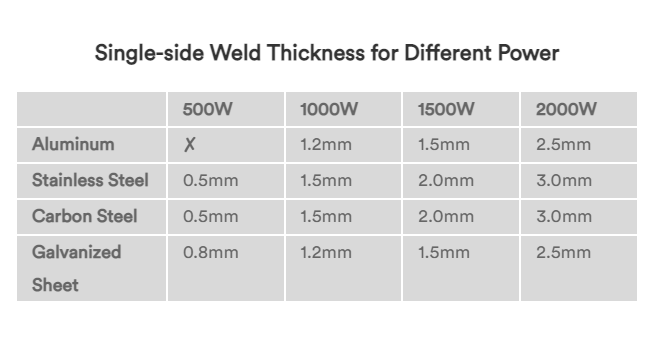What is laser welding? Laser welding vs arc welding? Can you laser weld aluminum (and stainless steel)? Are you looking for the laser welder for sale that suits you? This article will tell you why a Handheld Laser Welder is better for various applications and its added bonus for your business, with a detailed material rundown list to aid you in decision making.
New to the world of laser equipment or seasoned user of laser machinery, having doubts about your next purchase or upgrade? Worries no more because Mimowork Laser got your back, with 20+ years of laser experience, we are here for your questions and ready for your inquiries.

What is Laser Welding?
The fiber laser welder handheld acts on the material in a way of fusion welding. Through concentrated and huge heat from the laser beam, the partial metal is molten or even vaporized, joints the other metal after metal cooling and solidifying to form the welding joint.
Did you know?
A Handheld laser welder is better than a traditional Arc welder and here is why.
Compared with a traditional Arc welder, a laser welder provides:
• Lower energy consumption
• Minimum Heat Affected Area
• Barely or no Material deformation
• Adjustable and fine welding spot
• Clean welding edge with no further processing needed
• Shorter welding time - 2 to 10 times faster
• Emits Ir-radiance light with no harm
• Environmentally friendliness

Key characteristics of a handheld laser welder machine:
Safer
The commonly used protective gases of laser welding are mainly N2, Ar, and He. Their physical and chemical properties are different, so their effects on welds are also different.
Accessibility
A handheld welding system is equipped with a compact laser welder, providing convenience and flexibility without compromises, a weld can be easily performed and the welding performance is top of the line.
Cost Effective
According to the tests performed by field operators, the value of one handheld laser welding machine equals two times the cost of a traditional welding machine operator.
Adaptability
Laser Welding Handheld is simple to operate, it can easily weld stainless steel sheet, iron sheet, galvanized sheet and other metal materials.
Advancement
The birth of Handheld Laser Welder is a major technological upgrade, and it is the cruel beginning for the traditional laser welding solutions like argon arc welding, electric welding and so on to be replaced by modern laser welding solutions.
Materials commonly used for Laser Welding - Features and Tips:
This is a list of materials commonly used for Laser Welding, in additional some general features and characteristics of the materials in detail and some tips for you to achieve better welding results.
Stainless Steel
The thermal expansion coefficient of stainless steel is high therefore a stainless-steel work piece is easy to overheat when welding with traditional welding solutions, the heat affected area is a larger than normal with this material so it will lead to serious deformation problems. However, by using a handheld laser welding machine solves many problems as during the whole welding process the heat generated is low, coupled with the fact that stainless steel has a relatively low thermal conductivity, high energy absorption and melting efficiency. A beautifully formed, smooth weld can be obtained after the welding with ease.
Carbon Steel
A handheld laser welder can be directly used on ordinary carbon steel, the result is comparable to stainless steel laser welding, while the heat affected area of carbon steel is even smaller, but during the welding process, the residual temperature is relatively high, so it is still necessary to preheat the work piece before welding accompanied with heat preservation after welding to eliminate stress to avoid cracks.
Aluminum and Aluminum Alloys
Aluminum and aluminum alloy are highly reflective materials, and there may be porosity problems in the welding spot or the root of the work piece. Compared with the previous several metal materials, aluminum and aluminum alloy will have higher requirements for parameters setting of the equipment, but as long as the selected welding parameters are appropriate, you can get a weld with the mechanical properties of the base metal equivalent.
Copper and Copper Alloys
Usually, when using a traditional welding solution, the copper material will be heated in the welding process to assist welding due to high thermal conductivity of the material, such trait consequently may result incomplete welding, partial non-fusion and other undesired outcomes during welding. On the contrary, a Hand-held laser welder can be directly used for welding copper and copper alloys without complications thanks to extreme energy concentration abilities and fast welding speed of a laser welder.
Die Steel
The hand-held laser welding machine can be used for welding various types of die steel, and the welding effect always meets satisfactory.
Our recommended Handheld Laser Welder:

Laser Welder - Working Environment
◾ Temperature range of working environment: 15~35 ℃
◾ Humidity range of working environment: < 70%No condensation
◾ Cooling: water chiller is necessary due to the function of heat removing for laser heat-dissipating components, ensuring the laser welder runs well.
(Detailed use and guide about water chiller, you can check the: Freeze-proofing Measures for CO2 Laser System)
Wanna Know more about Laser Welders?
Post time: Dec-09-2022




